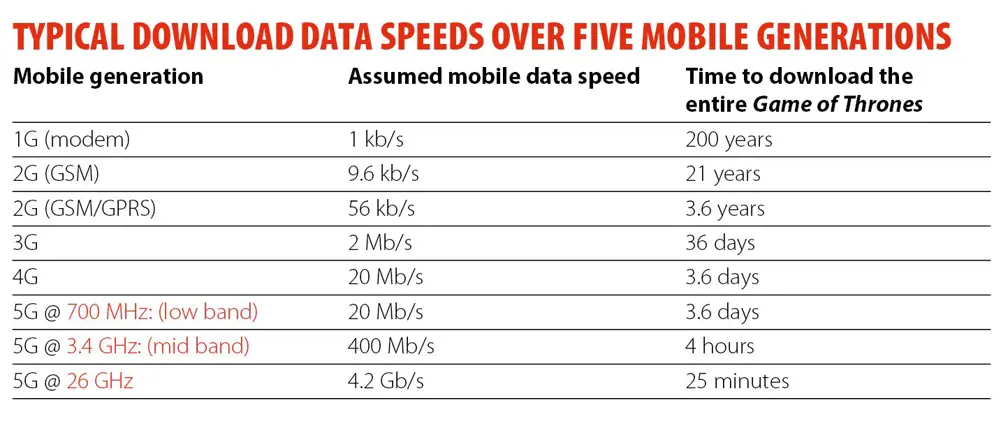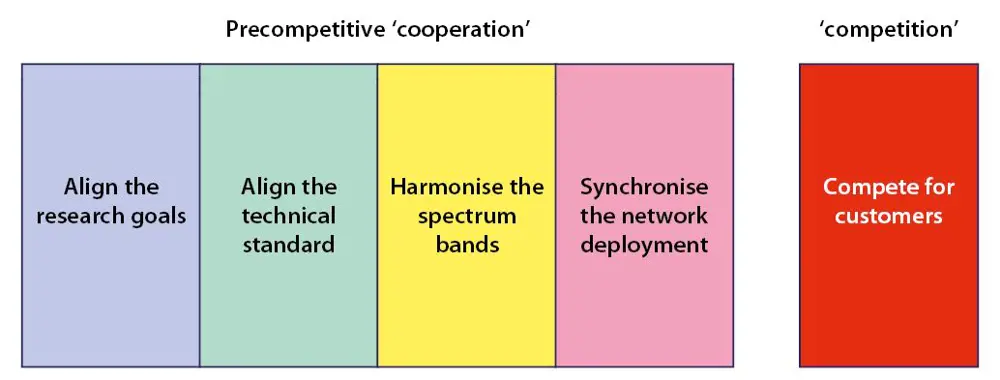
How to make a mobile technology revolution
Did you know?
📱 Laying the foundations for today’s mobile industry
- Launched in 1991, GSM laid the foundations for today’s global mobile industry
- A new generation of mobile technology (such as 3G, 4G, 5G) is launched roughly every 10 years
- It would have taken 200 years to download the entire eight seasons of Game of Thrones over 1G, while over today’s mid-band 5G it takes four hours
- A successful new mobile generation needs fully coordinated international collaboration in research, standards, spectrum bands, and network deployment
Every industry must manage technology change: a mix of successes and failures is seen as normal. What is unmatched in any other comparable field of high technology is that, over the past 30 years, not a single generation of mobile technology has failed. Since the launch of the GSM in 1991, all the generations of mobile technology since 2G have been open international collaborative projects.
all the generations of mobile technology since 2G have been open international collaborative projects
What is GSM?
🌐 What is GSM and the result of it’s huge global adoption
GSM (Global System for Mobile Communications) was Europe’s version of 2G that rose rapidly to become the dominant technical standard for mobile networks across the world. Its pervasiveness and collaboration between GSM mobile network operators made it possible, for the first time, for people to fly to another part of the world and their personal mobile phone just worked when they stepped off the plane. The huge volumes its global adoption generated brought mobile phone prices down so that even the poorest countries could afford them. The scale of GSM made it the standard of choice for innovations: the first Apple iPhone was a GSM mobile. Subsequent mobile generations have been able to start from the global foundation GSM created.
Technology evolution
New generations (G) of mobile technology have been launched roughly every 10 years:
- 1979: 1G aimed to generate more telephone capacity for phones in cars. However, car phones were seen as a frivolous use of scarce frequencies and so very few were released. 1G allowed the same frequency to be reused intensively across a country.
- 1991: 2G took mobile ‘digital’ and the GSM version spread across continents, allowing people to use their mobiles almost everywhere.
- 2001: 3G fused mobile networks with the internet.
- 2009: 4G dramatically ramped up network data capacity. The data explosion, ignited by Apple’s iPhone smartphone interface making it easy to access rich content like videos, was overwhelming 3G networks.
- 2019: 5G had three ambitions: the first was higher data speeds, the second was specialist ultra-reliable low-latency networks (for mission critical services), and the third was to ready mobile networks for billions of ‘things’ to be connected.

The frequency values shown in red illustrate the fundamental limitation of how far radio waves propagate versus how much data they can carry. This is likely to add to a high data speed ‘digital divide’ as national 5G coverage for high band could be 10 times less than 5G in mid band, which in turn could finish up to five times less than 5G in low band.
With such fast-paced innovation, it is easy to notice when data speeds begin to fall short. A popular way of measuring data speed progress is how long it takes to download the eight seasons of Game of Thrones – 70 hours of TV in total, with picture quality equivalent of watching Netflix at 25 Mb/s, resulting in 787.5 GB of data needing to be transported.
Creating a generation
As well as the evolution of data speeds, mobile technologies have developed significantly over the same time. Wireless technology is a key element in the success of mobile generations and advances in semiconductor technology have also been indispensable. Top-end smartphones now have 512 GB of storage, which is almost enough to store all eight seasons of Game of Thrones (in 1997, the impressive 8 MB of storage offered by the Nokia 9000i Communicator would not have been enough for the opening credits). On the demand side, better resolution cameras and displays are continuously ratcheting up the quantity of data to be transported over mobile networks.
Wireless technology is a key element in the success of mobile generations and advances in semiconductor technology have also been indispensable

The four elements that have to be brought together to create new mobile technology generations
There are four main elements that have to be coordinated to revolutionise a mobile technology generation. The first, which determines the future commercial and societal value of a mobile generation, is consensus building within the research community on the shared goals. The most successful of these have been those that set out to solve the big problems of the time.
The second element is creating technical standards to ensure every new mobile from any manufacturer will successfully work with every new network, in any country. The global standards body, 3rd Generation Partnership Project (3GPP), unites seven telecommunications standard development organisations. This could prove to be difficult with so many differing opinions and viewpoints, but the engineers involved have worked together to deliver high-quality standards for mobile technology across the last three generations.
The third element is harmonising spectrum bands, the radio frequencies allocated to the mobile industry and other sectors for communication over the airwaves. The disconnect between technology standards and radio spectrum regulation has been the weak link in the mobile network technology innovation model for some mobile generations. In mobile spectrum auctions, governments use an auction system to sell the rights to transmit signals over specific bands of the electromagnetic spectrum. The closest a mobile generation has come to failing was 3G because of an over-heating spectrum auction, where excessive price paid for 3G spectrum led to reduced 3G mobile coverage. Economists had put forward what has now proven to be a flawed theory that auctioning frequencies would place them in the hands of those likely to make the most effective use of them. What attracted governments more was the money that auctions would raise, particularly when competition would prevent mobile operators from recouping the money by raising prices to consumers. However, mobile operators recouped costs by cutting back investment in 3G coverage, leading to a decade of consumer complaints about poor 3G coverage.
the biggest single mobile radio engineering challenge over the next 10 years is going to be closing the digital divide and getting 1 Gb/s everywhere
The 4G auction was better managed, with a coverage obligation on a low band licence. It will take time to see the impact of the UK 5G auction prices, although the money raised in the first part alone could have paid for 100,000 small 5G base stations.
Why does the price of frequencies matter? The data speeds in the table and extent of possible coverage for different frequencies tells us that the biggest single mobile radio engineering challenge over the next 10 years is going to be closing the digital divide and getting 1 Gb/s everywhere. Those 100,000 small 5G base stations could have made a start.
The fourth element is synchronising the network roll-out with development of new devices. Nobody will buy a next-generation mobile if there isn’t a next-generation network to connect it to and there is no point in rolling out a next-generation network if there are few next-generation mobiles in consumers’ hands.
A synchronised roll-out will also secure early-scale economies and falling equipment prices. This was first achieved in Europe when the four largest countries decided that their mobile operators would all sign up to switch on GSM networks in 1991.
Laying the foundations
How did the ‘repeat pattern’ of a new technology generation roughly every 10 years arise? Some of the 1G network did work well, and an analogue phone that could fit in a shirt pocket was launched in 1986, so GSM had a huge amount of catching up to do. A higher data speed mobile technology was just around the corner and GSM was in danger of being squeezed out. ETSI, the officially recognised standards body in Europe for making telecoms standards, deliberately slowed the advance of a new wider band standard so that it would not compete with GSM. Instead, it was made a third generation by design.
ETSI’s expedient invention of ‘the mobile generation’ turned out to be an enduring valuable tool that laid the foundation for today’s phenomenally successful global mobile industry. It also addresses a particular innovation market failure, where nothing can happen unless an entire industrial ecosystem acts together. Its model of coordinating the four elements has delivered huge commercial, industrial, and societal benefits on a global scale. Created for the GSM revolution 30 years ago, the model has secured the success of another three mobile revolutions and is currently providing the confidence for the research community to begin its new journey towards 6G.
***
This article has been adapted from "How to make a mobile technology revolution", which originally appeared in the print edition of Ingenia 87 (June 2021).
Contributors
Professor Stephen Temple CBE FREng joined the Department of Trade and Industry in 1984 a year before the UK launched its 1G mobile networks. He led for the UK in the GSM standards group and has been involved in various ways in 3G, 4G and 5G mobile generations. He recently edited the Institution of Engineering and Technology guide 6G for policymakers and chairs cluster two of the UK Spectrum Policy Forum.
Keep up-to-date with Ingenia for free
SubscribeRelated content
Technology & robotics

When will cars drive themselves?
There are many claims made about the progress of autonomous vehicles and their imminent arrival on UK roads. What progress has been made and how have measures that have already been implemented increased automation?

Autonomous systems
The Royal Academy of Engineering hosted an event on Innovation in Autonomous Systems, focusing on the potential of autonomous systems to transform industry and business and the evolving relationship between people and technology.

Hydroacoustics
Useful for scientists, search and rescue operations and military forces, the size, range and orientation of an object underneath the surface of the sea can be determined by active and passive sonar devices. Find out how they are used to generate information about underwater objects.

Instilling robots with lifelong learning
In the basement of an ageing red-brick Oxford college, a team of engineers is changing the shape of robot autonomy. Professor Paul Newman FREng explained to Michael Kenward how he came to lead the Oxford Mobile Robotics Group and why the time is right for a revolution in autonomous technologies.
Other content from Ingenia
Quick read

- Environment & sustainability
- Opinion
A young engineer’s perspective on the good, the bad and the ugly of COP27

- Environment & sustainability
- Issue 95
How do we pay for net zero technologies?
Quick read

- Transport
- Mechanical
- How I got here
Electrifying trains and STEMAZING outreach

- Civil & structural
- Environment & sustainability
- Issue 95